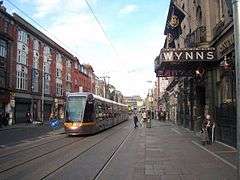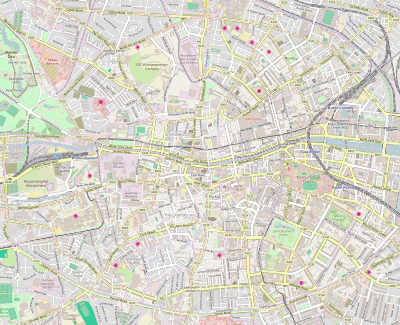Wynn's Hotel, Dublin
Wynn's Hotel is a historic hotel located on Abbey Street in Dublin, Ireland which is connected to the city's main thoroughfare, O'Connell Street. The hotel, which opened in 1845, played a vital role leading up to the 1916 Easter Rising and other significant Irish events. The now three star hotel is a tourist attraction in Dublin city, and is known for its pristine condition after being reconstructed a decade after its destruction.
| Wynn's Hotel | |
|---|---|
 The entrance of the hotel on Abbey Street | |
 Location within Central Dublin | |
| Alternative names |
|
| General information | |
| Type | Mass concrete |
| Classification | |
| Location | Dublin, Ireland |
| Address | 36-38 Abbey Street Lower Dublin 1 D01 C9F8 |
| Coordinates | 53°20′54.031″N 6°15′31.277″W |
| Elevation | 4 metres (13 ft) |
| Opened |
|
| Destroyed | 27 April 1916 |
| Owner |
|
| Technical details | |
| Floor count | 6 |
| Design and construction | |
| Architect | Peter Russell |
| Main contractor | G & T Crampton Ltd. |
| Other information | |
| Parking | Street |
| Website | |
| wynnshotel | |
History
Early years
The hotel opened in 1845 as a boarding house by Phoebe Wynn. Wynn was well connected with the Church of Ireland, and the establishment was popular with Church of Ireland clergy staying in Dublin.[1] Wynn owned the hotel for only seven years, but the owners after her kept the name. The change of ownership meant, however, that it now became the favoured city haunt of the Catholic clergy.[1] After her subsequent ownership, the boarding house was registered as a hotel on 10 July 1897 and has operated ever since.[2] In early 1897, the hotel's name changed to Telford's but the name changed back to Wynn's when it was acquired by the Clarence Hotel Company in 1898.[3]
Foundation of the Irish Volunteers and Cumann na mBan
Wynn's hotel was the venue for a meeting of Irish nationalists, held on 11 November 1913, with a view to forming an armed body. The meeting was arranged by Bulmer Hobson and The O'Rahilly, and chaired by Eoin MacNeill which resulted in the creation of the Irish Volunteers.[4] Within hours of the meeting, the hotel was visited by two detectives who advised the manager not to hold such meetings in future; nonetheless, subsequent meetings of the committee were held at the hotel.[4] A plaque in the hotel bar commemorates the first meeting.[5] On 2 April 1914, Cumann na mBan, a women's auxiliary of the Volunteers, was formed at a meeting of nationalist women in Wynn's, chaired by Agnes O'Farrelly.[6]
1916 Easter Rising and the aftermath
During the Easter Rising of 1916, Wynn's was burned to the ground.[7] It was set on fire by incendiary bullets hitting a street barricade which was erected outside. Owing to the fighting, firefighters were unable to save the hotel. Guests and staff were accommodated in the Clarence Hotel located on the opposite side of the River Liffey on Wellington Quay.[8] Following the Rising, there was nothing left of the hotel. In 1921, the hotel began being rebuilt using mass concrete, the first building to do so in Dublin at the time. It was re-opened in 1926, ten years after its destruction.[9]
References
- "History: Wynn's Hotel Opening". Wynns Hotel website. Retrieved 10 March 2017.
- "Wynn's Hotel Limited - Irish Company Info - SoloCheck". www.solocheck.ie. Retrieved 2017-06-04.
- "History: Hotel Name Changed". Wynns Hotel website. Retrieved 10 March 2017.
- Hobson, Bulmer (2013). "Foundation and Growth of the Irish Volunteers, 1913-14". In Martin, F. X. (ed.). The Irish Volunteers 1913-1915. Merrion. pp. 38–9. ISBN 9781908928252.
- Ciarán (6 April 2012). "Plaques of Dublin: Wynn's Hotel and the Irish Volunteers". Come Here to Me!. Retrieved 10 March 2017.
- "Cumann na mBan - Forgotten Women of Revolution". RTÉ. Retrieved 10 March 2017.
- O'Brien, Joseph V. (1982). Dear, Dirty Dublin: A City in Distress, 1899-1916. University of California Press. p. 269. ISBN 0520039653. Retrieved 10 March 2017.
- "Background". Wynns Hotel website. Retrieved 10 March 2017.
- "History: Clarence Hotel Company". Wynns Hotel website. Retrieved 10 March 2017.